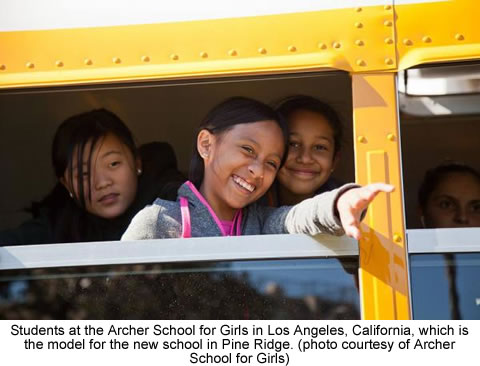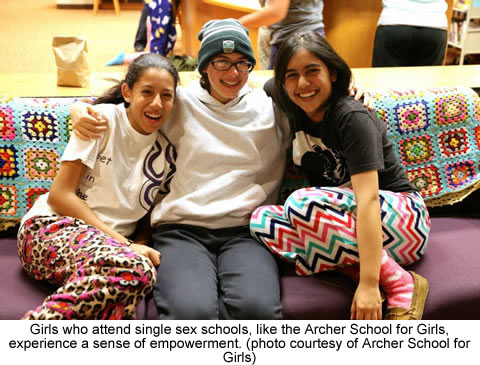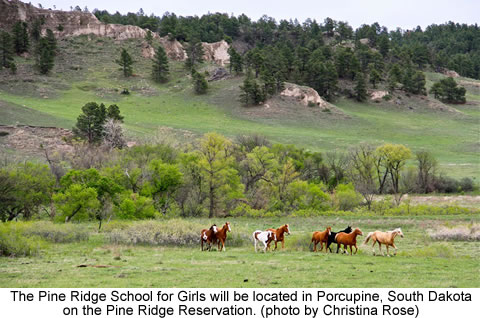 |
Canku Ota
|
 |
|
(Many Paths)
|
||
|
An Online Newsletter
Celebrating Native America
|
||
|
April 2014 - Volume
12 Number 4
|
||
|
|
||
|
All Girls Prep School
Coming to Pine Ridge
|
||
|
by Christina Rose -
Indian Country Today Media Network
|
||
|
In California, the Archer School For Girls was founded in 1995 with 30 students and has grown to almost 500 students. One of the founders, Victoria Shorr-Perkins said she had heard so much about people founding schools for girls overseas. "It occurred to me after reading about Pine Ridge, maybe we could found a girls school there," she said. Shorr-Perkins attended a girl's school and is a firm believer in single sex education. "When you put girls in an all-girl environment, they become capable of taking flight. If the girls from Pine Ridge could find their voice, they could reformat the justice system, they could be president, they could do anything, but they need the education," she said.
In the first year, the Pine Ridge Girls School is expected to serve approximately 30 girls in the sixth and seventh grades, and will add a grade every year through high school. The first year's budget is projected at $500,000, and the new school board is already in the throes of fundraising. "We are on a very aggressive timeline because these girls need this school," Shorr-Perkins said. "We need foundation support. The school will be tightly controlled fiscally because we will be following an existing model." Pine Ridge is one of the poorest counties in the country with estimates of unemployment as high as 80 to 90 percent, and per capita incomes as low as $5,213 per year. According to Iron Cloud, the schools on the reservation struggle simply to provide an education. "Schools don't even have the resources for academics, much less the resources to intervene when someone has experienced grief or loss, and then to provide a culturally appropriate response," she said. "I see how so much potential is lost because of the things kids experience at a young age on the reservation," Iron Cloud said. "That impacts their educational experience. By intervening with good education and healing, we have more of an opportunity to help children achieve their full potential."
The cultural opportunities abound. The school will incorporate inipi ceremonies and age-appropriate rites of passage. "The kinship relationships are what held us together traditionally. We will not just be looking at them as students, but as our relatives," Iron Cloud said. "Regular education is detached. Of course there are boundaries, but if we look at them as relatives we will treat them in respectful and honorable ways, as tojan (niece) or takoja (grandchildren)." The curriculum will include nutrition and kinship with all beings. "The nutritional part is key, as is conservation. It is important to teach kinship with environment, with the stars, the trees, the water, the buffalo, the winged nation," Iron Cloud said. The school will also incorporate community and cultural healing activities that are already in place in Porcupine, South Dakota through organizations such as the Medicine Horse Society and the Knife Chief Buffalo Nation.
"The curriculum will follow common core standards, with the basics of reading, writing, and math. They will be spending a lot of time building the basic skills." Building skills is critical for students on the reservation. According to Bureau of Indian Education statistics, the average achievement rates for high schools in Pine Ridge are 79 percent at basic, 19.6 percent are proficient, and 0.79 percent are advanced. These scores are vastly lower than public school statistics in South Dakota, where some school's advanced achievement scores are as high as 40 percent. Champagne is on the board of similar tribal schools in California. "In one school they are writing essays in the third grade, so they score well and are competitive in their skills. The goal is for every child to go to college, and starting that focus in young grades," he said. "Everyone is in favor of good education, but there is frustration because the public schools have not produced. It's only recently that the tribes have the money to do these experimental schools. It's really exciting and shows a clear pattern," Champagne said. "It's the first time a school will be melding what works best for girls and what works best for the Lakota. It's taking the girls' school research around the next corner," Shorr-Perkins said. "And the thing is, this school model can be tweaked for boys and inner-city, and I look forward to it happening. The school will serve as a community resource, and we will have a functioning greenhouse facility, theatre arts, cross-country skiing. It will work for the whole community." "In 50 years will anyone be speaking in Lakota," Iron Cloud asked. "Will they be speaking in kinship terms, and how do we make this happen? We need to sacrifice and show our commitment to this way of life. It's not only about educational achievement, it is about putting something in place that will benefit the people. We have to look out for each other as people."
Medicine
Horse Society Knife
Chief Buffalo Nation |
|
|
||
|
|
||
| Canku Ota is a free Newsletter celebrating Native America, its traditions and accomplishments . We do not provide subscriber or visitor names to anyone. Some articles presented in Canku Ota may contain copyright material. We have received appropriate permissions for republishing any articles. Material appearing here is distributed without profit or monetary gain to those who have expressed an interest. This is in accordance with Title 17 U.S.C. Section 107. | ||
|
Canku Ota is a copyright ©
2000 - 2014 of Vicki Williams Barry and Paul Barry.
|
||
 |
 |
|
|
The "Canku
Ota - A Newsletter Celebrating Native America" web site and
its design is the
|
||
|
Copyright ©
1999 - 2014 of Paul C. Barry.
|
||
|
All Rights Reserved.
|
||
 By
September of this year the Pine Ridge Reservation in South Dakota
may have a new all-girls college preparatory school. The school
will combine college level classes, traditional culture and language
in a safe, stable environment. This proven model is currently in
the planning stages.
By
September of this year the Pine Ridge Reservation in South Dakota
may have a new all-girls college preparatory school. The school
will combine college level classes, traditional culture and language
in a safe, stable environment. This proven model is currently in
the planning stages. Ethleen
Iron Cloud-Two Dogs, Oglala, who served on the Bureau of Indian
Affairs Advisory Board for Exceptional Children, and Deborah Bordeaux,
Oglala, long-time educator and education advocate, are bringing
this vision to Pine Ridge, Shorr- Perkins said. "It has to be education
through empowerment. Most people who go to college and do well have
been empowered since kindergarten. In many reservation schools,
children have been disempowered since kindergarten."
Ethleen
Iron Cloud-Two Dogs, Oglala, who served on the Bureau of Indian
Affairs Advisory Board for Exceptional Children, and Deborah Bordeaux,
Oglala, long-time educator and education advocate, are bringing
this vision to Pine Ridge, Shorr- Perkins said. "It has to be education
through empowerment. Most people who go to college and do well have
been empowered since kindergarten. In many reservation schools,
children have been disempowered since kindergarten." Iron
Cloud added that statistics show that many girls in Pine Ridge experience
violence and sexual violence at a young age. The education system
on the reservation assumes children come to school ready to learn,
ignoring the fact that some children have experienced trauma. Iron
Cloud noted, "We will provide an environment of healing for learning.
This is an opportunity to provide a comfortable environment for
the girls."
Iron
Cloud added that statistics show that many girls in Pine Ridge experience
violence and sexual violence at a young age. The education system
on the reservation assumes children come to school ready to learn,
ignoring the fact that some children have experienced trauma. Iron
Cloud noted, "We will provide an environment of healing for learning.
This is an opportunity to provide a comfortable environment for
the girls." Empowerment,
culture, healing, and college preparatory education sum up the goals
of the school. "There will be some kids who need help and some kids
who need an opportunity," board member Duane Champagne said. "We
are looking for the kids to be the leaders of the future, so when
they go to college they have the skills to succeed. We need them
to get the leadership skills and bring them back to the reservation
or take them out into the world.
Empowerment,
culture, healing, and college preparatory education sum up the goals
of the school. "There will be some kids who need help and some kids
who need an opportunity," board member Duane Champagne said. "We
are looking for the kids to be the leaders of the future, so when
they go to college they have the skills to succeed. We need them
to get the leadership skills and bring them back to the reservation
or take them out into the world.